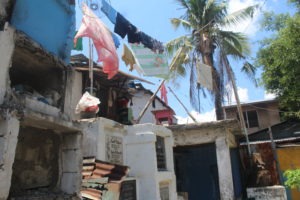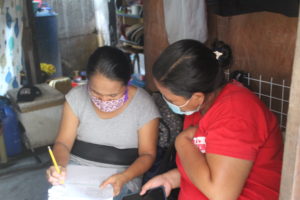Sheba Babac is an active DPC member of Tanza-Timawa 2, Iloilo City and thus sees how her fellow urban poor strive to survive every day. Furthermore, their experiences have enabled them to grow and cope with other problems that they are, and will be, facing.

Tanza-Timawa 2 is a community inside a cemetery, which is why it is locally known as “Tanza-Patyo” (Tanza-Cemetery). It has a land area of 0.0446 km2, and a total population of 2009. Tanza-Timawa 2 has a population density of 45,065 km2, much higher than the average population density of the whole Iloilo City (5,700/km2).
As an urban poor community, houses there are very close to each other and are usually made of light materials. Electric jumpers, or devices that illegally connects to the main electrical line to “steal” electricity, are also commonly used, which makes the community prone to fire.
The last disastrous fire they encountered was in 2010, where the whole community was affected. PCDR was one of the organizations that responded during that incident.
The fire in 2010 enabled them to learn a lot of lessons like being attentive to their usage of electricity, and cooperate to put the fire out since it is difficult for fire trucks to enter their community due to lack of road big enough for fire trucks to pass. Since then, the community has not experienced huge fires until the present. Small fires are easily prevented from spreading to the entire community because of the cooperation of the people themselves.
Currently, urban poor communities in Iloilo City are struggling under the effects of COVID-19 pandemic. Many were left jobless due to the closing of establishments, drivers’ income were also affected with the implementation of 50% passenger capacity, and etc. However, last March, prior to the spike of COVID-19 cases in Iloilo City, Sheba, together with other DPC members and community organizers have successfully conducted information dissemination and distributed 500 COVID-19 brochures made by PCDR to Tanza-Patyo and other urban poor communities in Iloilo City.
On the top of all these, community health trainings and the formation community health teams are being conducted through a broader alliance called Fight COVID-19 People’s Alliance (FCPA), which PCDR and KAISOG are part of. As of the moment, FCPA has already conducted Health Trainings to 12 Barangays around Metro Iloilo.
Moreover, the FCPA’s regular community feeding program has served 12 Barangays, while FCPA’s relief delivery operations has already served 18 Barangays around Metro Iloilo (see attachment).
Drawing lessons from the dengue outbreak last year, the community now sees the importance of sanitation, which is also vital in fighting COVID-19.
 Last May, Sheba led the PCDR staff in the conduct of the Knowledge, Attitude, and Practice Survey (Tool #9), and the Household Disaster Readiness Survey (Tool #10) in Barangay Tanza-Timawa 2, Iloilo City. Based on the results of the survey, Sheba realized that even though community’s cooperation in times of disasters is present, there is still a need for massive and comprehensive trainings especially in the aspect of disaster management.
Last May, Sheba led the PCDR staff in the conduct of the Knowledge, Attitude, and Practice Survey (Tool #9), and the Household Disaster Readiness Survey (Tool #10) in Barangay Tanza-Timawa 2, Iloilo City. Based on the results of the survey, Sheba realized that even though community’s cooperation in times of disasters is present, there is still a need for massive and comprehensive trainings especially in the aspect of disaster management.
To Sheba, cooperation among community members as well as coordination with organizations outside the community are important to combat different problems being encountered by the community. It is also important in making the organization stronger to fight future problems they will be facing.
